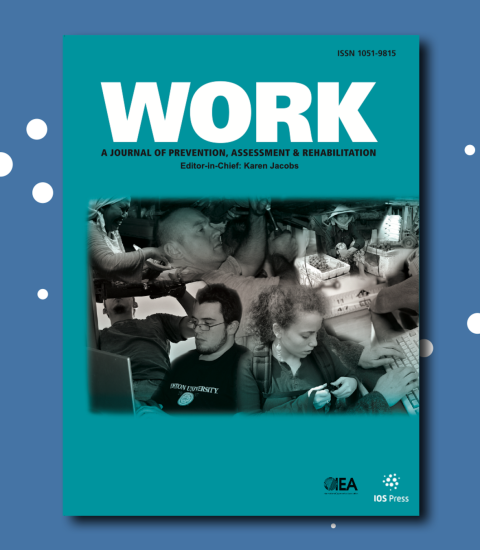
Work can in many ways be regarded as one of the primary human needs. It may provide a source of income, contribute to social contacts, and is for many an important life value, providing social and intellectual growth. In musculoskeletal rehabilitation, return to work is often identified as one of its main targets. However, there is much to overcome to make work a healthy place for everyone.
Guest Editor Karen Jacobs, OT, EdD, OTR, CPE, FAOTA, Sargent College of Health and Rehabilitation Sciences, Boston University, Boston, MA, USA, and Editor-in-Chief of WORK, says, "It was a pleasure to have the opportunity for collaboration between the two journals on this important topic of work-related pain. We aim to raise awareness of the challenges we face and propose a call for action to make work a safe place for every individual, where they can evolve and build up a fair income to support their lives."
Guest Editor Remko Soer, PhD, University of Groningen, University Medical Center Groningen, Department of Anesthesiology, Pain Center, Groningen, and mProve Hospitals, Zwolle, Netherlands, and Editor-in-Chief of the Journal of Back and Musculoskeletal Rehabilitation, adds, "We need to shift away from the vision of work as just a risk factor, and instead strive for a situation in which wellbeing, life values, development and health are the outcomes. We can learn so much from those enduring in work despite having musculoskeletal conditions and how employers actively support people with disabilities, minority backgrounds, or older age."

Dr. Soer notes, "While we see that physically demanding work is a significant risk factor for musculoskeletal injury, safety at the workplace is a prerequisite for a healthy work environment. Especially within low- and middle-income countries, work circumstances can be considered poor in some industries. In Western society, with growing demands, a 24-online culture has been introduced, leading to a blurring of boundaries between private and professional life. Increasingly, people call absent from work because of continuous stress, leading to burnout, depression, fibromyalgia, or other chronic pain conditions."
This special issue contains 15 insightful papers related to pain that focus on topics such as burnout, work ability, quality of life, occupational rehabilitation, return to work, and ergonomics.
One of the featured articles in this issue is Efficacy of occupational rehabilitation in return to work for back pain: A systematic literature review, by Linda Kalski, Laura Völkel, Sarah Häußler, and Bernd Wolfarth. The authors investigated the efficacy of occupational rehabilitation programs for workers with back pain, as there is no standard procedure for a return to work (RTW) rehabilitation program used by practitioners. This evidence-based review concluded that a combination of activity, maintenance therapy, stretching, and manual therapy showed promising results in improving RTW. In addition, the relationship and mediation between employer/workplace and employee seem to be important aspects of RTW. Notably, pain intensity, disability, and quality of life were enhanced with interventions that included a high proportion of physical activity. Also, the intervention programs differed widely, leading to the observation that the treatment effect of the intervention programs is not established yet.
The issue also acknowledges the growing recognition of the role of psychological and social factors in pain management. Strategies such as cognitive behavioral therapy (CBT) and acceptance and commitment therapy (ACT) are being used more frequently. This reflects the shift towards non-pharmacological approaches to managing pain in the wake of the opioid crisis.
Applications of new technologies are explored in this issue. These include the use of virtual reality (VR) and artificial intelligence (AI) for pain management and wearable devices to track physiological data in real-time, helping to determine pain intensity and the effectiveness of treatments. AI and machine learning are expected to facilitate more personalized treatment options.
Collectively, the articles in this issue show that work-related pain management requires an interdisciplinary approach integrating medical, psychological, and occupational therapies to prevent work-related illness, injury, and disability. When prevention is not achievable, the focus should shift to designing person-centered interventions, rehabilitation, treatment, or controls. Disclosing a pain condition at work can be complicated due to stigma. The unpredictability of pain conditions or their progression can make managing work-related pain difficult.
Dr. Jacobs concludes "We sincerely encourage researchers, clinicians, employers, and policymakers to continue work on this important topic and continue to create awareness to improve work circumstances for all individuals across the globe."
# # #
NOTES FOR EDITORS
Special Issue: Work-Related Pain
Guest Editors:
Karen Jacobs, OT, EdD, OTR, CPE, FAOTA, Sargent College of Health and Rehabilitation Sciences, Boston University, Boston, MA, USA, and Editor-in-Chief of WORK
Remko Soer, PhD, University of Groningen, University Medical Center Groningen, Department of Anesthesiology, Pain Center, Groningen, and mProve Hospitals, Zwolle, Netherlands, and Editor-in-Chief of the Journal of Back and Musculoskeletal Rehabilitation
WORK, Volume 78, Issue 1, published by IOS Press
The special issue is available at https://content.iospress.com/journals/work/78/1
Featured article: “Efficacy of occupational rehabilitation in return to work for back pain: A systematic literature review,” Linda Kalski, Laura Völkel, Sarah Häußler, and Bernd Wolfarth (https://doi.org/10.3233/WOR-230277)
It is openly available at https://content.iospress.com/articles/work/wor230277
.
Credentialed journalists should contact Diana Murray for more information or to request PDFs of the articles at +1 718-640-5678 or d.murray@iospress.com. The Guest Editors and authors may be contacted via Karen Jacobs, OT, EdD, OTR, CPE, FAOTA, at kjacobs@bu.edu.
ABOUT WORK: A JOURNAL OF PREVENTION, ASSESSMENT & REHABILITATION
WORK: A Journal of Prevention, Assessment & Rehabilitation is an interdisciplinary, international journal that publishes high quality peer-reviewed articles covering the entire scope of the occupation of work. The journal's subtitle has been deliberately laid out: The first goal is the prevention of illness, injury, and disability. When this goal is not achievable, the attention focuses on assessment to design client-centered intervention, rehabilitation, treatment, or controls that use scientific evidence to support best practice. https://workjournal.org
ABOUT THE JOURNAL OF BACK AND MUSCULOSKELETAL REHABILITATION
The Journal of Back and Musculoskeletal Rehabilitation mainly focuses on presenting relevant information about the interdisciplinary approach to musculoskeletal rehabilitation for clinicians who treat patients with back and musculoskeletal pain complaints. It provides readers with both 1) a general fund of knowledge on the assessment and management of back and musculoskeletal disorders and 2) new information considered to be state-of-the-art in the field. The intended audience is multidisciplinary as well as multi-specialty. https://www.iospress.com/catalog/journals/journal-of-back-and-musculoskeletal-rehabilitation
ABOUT IOS PRESS
IOS Press, now part of Sage, is an international scientific, technical, medical (STM) publishing house established in 1987 in Amsterdam. We produce around 90 journals and 70 books annually in a broad range of subject categories, primarily specializing in health and life sciences (including neurosciences, medical informatics, cancer research, and rehabilitation) and computer sciences (including artificial intelligence, data science, and semantic web). In addition, we offer specialized services that support scientific advancement. www.iospress.com
ABOUT SAGE
Sage is a global academic publisher of books, journals, and library resources with a growing range of technologies to enable discovery, access, and engagement. Believing that research and education are critical in shaping society, 24-year-old Sara Miller McCune founded Sage in 1965. Today, we are controlled by a group of trustees charged with maintaining our independence and mission indefinitely. https://group.sagepub.com
